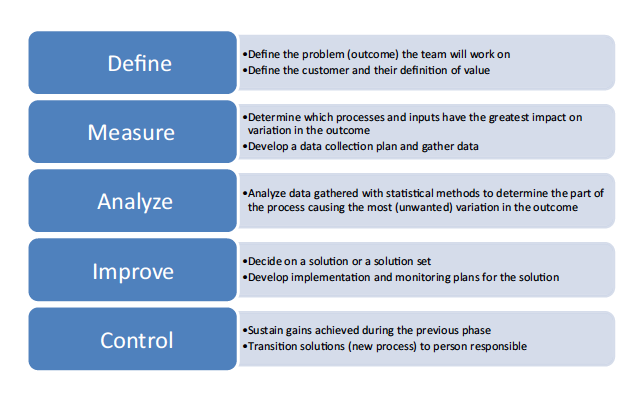
What is Six Sigma?
Six Sigma is a measurement-based strategy for process improvement. It’s a methodology, which aims at improving process and increasing customer satisfaction (Both internal & external). The concept behind this approach is to reduce the variation in processes. This reduction leads to consistent and desired outcomes from processes. Hence, Continuous process improvement with low defects is the goal of this method.
The overarching goal of the improvement approach known as Six Sigma is to reduce variance in outcomes by using data and statistical methods to improve system performance. An engineer at Motorola first developed (and later trademarked) Six Sigma in 1986 as a quality control measure. The company wanted to improve its manufacturing and inspection processes, which, at the time, did not adequately detect and correct defects. The term is derived from the 18th letter of the Greek alphabet (σ). In statistics, sigma refers to a standard deviation, so Six Sigma is six standard deviations, signaling an event that has a .0000035% chance of occurring (or 1 out of 285,715 events) — an admirable goal for maintaining a defect free process. When Motorola University — the company’s internal training system — began offering Six Sigma courses to external audiences, the approach spread to other companies (notably including General Electric in 1995). Much of the terminology of Six Sigma is based on business and manufacturing, and, because it’s still fairly new, the approach hasn’t yet had widespread use in educational systems.
FUNDAMENTALS OF THE MODELSix Sigma is predominantly a project-based model used to improve discrete processes with a team of experts on that specific issue and experts in the Six Sigma methodology. Districts have applied the method to address issues in operations, curriculum, and instruction. Colorado’s Adams County School District 12 (ACSD 12), for example, used Six Sigma to identify causes of poor air quality in classrooms that were triggering asthma attacks and increasing absences among students. The district assembled a team of teachers, custodians, and an external environmental specialist. By using the Six Sigma methodology, they identified the primary contributors — classroom pets whose cages weren’t cleaned frequently enough and books left on top of vents. After the team developed protocols for cleaning cages and keeping vents clear, teachers and students reported improved air quality. The district’s chief operating officer, Pat Hamilton, who was environmental manager at the time, credits Six Sigma with enabling them to “roll out the program very quickly across the district.” What’s more, according to “Using Six Sigma to Solve Issues in the Public School System” on the Six Sigma website, “the teachers were thrilled that their grievances had been listened to, and that a solution had been found.”
Adams CSD also turned to Six Sigma to figure out why standardized tests were suggesting inconsistent performance among the district’s high schools, a situation that posed a significant worry at that time due to the accountability regulations of the federal No Child Left Behind act. A team of high school teachers using Six Sigma tools found the problem stemmed from the district’s practice of allowing each high school to select its own textbooks, “which introduced variation in what children were taught and, consequently, learned,” write LeMahieu, Nordstrum, and Cudney. Adams ran a two-year pilot program giving all ninth and tenth grade students the same textbook and curriculum. At the end of that time, the students were all learning the same material making standardized test results quantifiable across the district.
Unlike the Networked Improvement Model (also examined in the special issue), Six Sigma does not have formal mechanisms for using knowledge gleaned from one project to inform future projects. Each project team decides whether or not to access earlier improvement records. Successful strategies implemented throughout a company become the basis for future improvement work.
Six Sigma provides many tools and techniques that rely heavily on the formal training of individuals who use it, which can be a drawback. Many companies have created teams of Six Sigma experts whose full-time job is to lead Six Sigma projects. The central tool is the five-step DMAIC (define, measure, analyze, improve, control) roadmap, pictured here and discussed in greater detail below.

The DMAIC Roadmap
DefineThe “define” stage of Six Sigma aims to identify the key stakeholders involved and design goals that address the needs of those stakeholders. When defining stakeholders – those people by the inefficiency – Ford arrived at three groups, consisting of end customers, process owners, paint shop workers and others.
They then set specific and quantitative goals to address the problem:
- Reduce costs – lower production costs by $1.5 million annually by lowering the consumption of paint in manufacturing.
- Improve customer satisfaction – meet customer needs better with a reduction of 127.000 ppm (defective parts per million).
- Reduce environmental impact – lower consumption of certain paint compounds to achieve a 50,000-kg reduction in Volatile Organic Compounds (VOCs).
The “measure” step in Six Sigma measures current processes which relate to your problem or inefficiency. This part is crucial to collecting data revealing root causes that can be addressed.
“The “measure” step in Six Sigma measures current processes which relate to your problem or inefficiency.”
In Ford’s case, they measured the following critical factors:
- Daily basecoat consumption
- Paint coat thickness
- Paint consumption per robot (for automated paint stations)
- Consumption per human painter (for manual paint stations)
- First-time through rate versus consumption; and
- Technical problems with application equipment
The “analyze” step aims to determine the root cause(s) related to the problem you want to address, based on relevant data you’ve gathered. Ford’s team analyzed the data collected when measuring the six factors above and pinpointed one major contributing factor to the problem.
There were two likely root causes found for excess paint consumption during production as follows:
- Higher consumption in robots applying paint to the lift gate.
- A fault in the solvent recovery valve of the application equipment. This meant that paint that should have been applied was leaking into the sprayers’ recovery tank.
“Improve” is a step which focuses on finding solutions to or improvement actions to eliminate the root causes found during the previous step. The team at Ford found they could replace the automated process of painting lift gates with manual application to solve the consumption issue there. They also found four potential solutions for improvement that addressed all of their goals:
| Goal | Target | Result |
|---|---|---|
| Lower costs | $1.5 million annually | $2 million annually |
| Improve customer satisfaction | 127.000 ppm reduction | 129.000 ppm reduction |
| Reduce environmental impact | Lower VOCs by 50.000 kg annually | Lowered VOCs by 70.000 kg annually |
- Replace plastic valves with more durable stainless steel valves
- Create an automated system to check valve recovery
- Manually check valves weekly; and
- Eliminate the solvent recovery process
Following test trials, the team found that replacing the plastic valves and creating the automated valve check system were the two solutions that best met their goals. When the changes were implemented, the plant actually saw improvement beyond what they set as targets in the goals they set.
ControlThe last step in the DMAIC method of Six Sigma is “control”. This step is critical to maintaining the improvements realized when implementing measured to address the root causes of a problem.
Ford continued to use their new automated system to check valve recovery. They also included this in criteria for ISO 9001 quality systems management audits at the plant. Routine audits help to ensure paint consumption is continuously managed and within specifications.
The Six Sigma approach identifies and prioritizes problems in response to customer needs. The method’s goal is to understand and control variation in an organization’s work processes, which are caused by the “six M’s”: materials, method, machines, manpower, measurement, and mother nature. Issues to be addressed can be categorized as: decreasing unreliability in processes; eliminating waste; identifying and decreasing the incidence of defects; reducing costs of processes; and improving customer satisfaction.
These were the issues hampering efforts to improve Milwaukee schools in 2011, when the Greater Milwaukee Foundation created Milwaukee Succeeds. Many groups were trying to help, but weren’t working together, placing the education community in the anomalous position of being program rich and systems poor. Designed as a collective-impact organization, Milwaukee Succeeds uses Six Sigma (in conjunction with other quality improvement approaches) to work toward providing a quality educational experience for every child from infancy to young adulthood. Milwaukee Succeeds unites nonprofits, schools, community groups, and government agencies around four topical networks based on common goals: School readiness, third-grade reading, postsecondary and career readiness, and community and social support.
SIX SIGMA IN ACTION: FINDING, TESTING, AND SPREADING SOLUTIONSSolutions come from the Six Sigma team, a small group that works on the improvement project full-time for a period of months. Team members are assigned responsibilities according to their level of training. A Six Sigma Black Belt — well-versed in the Six Sigma method — leads each team. The Milwaukee Succeeds topical networks, for example, are led by coaches with six months of training. The improvement team often includes one or more Green Belts (those with some training in the method) as well as others with expert knowledge on the organizational process that needs to be improved. Each team also has a senior management champion, whose role is to advocate for the project. The diversity of perspectives on the team — which includes someone with expertise in understanding what customers (students) want and need — is purposeful and is meant to enrich the identification of possible solutions.
Potential solutions arise during the define, measure, and analyze phases of the DMAIC roadmap. The team then decides which solutions to test, doing so on a small scale and multiple times under various conditions. The Six Sigma toolkit includes resources (many of them statistical methods) for analyzing the test results. Changes that are deemed improvements are then handed off to the workers who are responsible for the (now improved) process. The third-grade reading network in Milwaukee Success has piloted workshops — now led by parent coordinators — to teach family members how to better support their child’s reading. Using Six Sigma, the reading network has also been testing coordination meetings between different types of coordinators based on their backgrounds, such as whether they work in school-based or community-based contexts.
During the control phase of the DMAIC roadmap, the improvement team transfers what it has learned to colleagues who will sustain the work. Regular meetings between the team, team champion, and organizational management facilitate this sharing of knowledge, as do Six Sigma tools like the stakeholder analysis chart (which diagrams attitudes and support levels of stakeholders).
The Six Sigma approach is a resource-intensive one. It requires a group of trained improvement team members who are able to devote much (if not all) of their time to what are often months-long improvement projects. Perhaps for that reason, and perhaps because the method is heavy on statistics and manufacturing-based language, the approach is not yet used much in the education sector. However, its focus on data analysis is likely to be quite familiar to educators who are increasingly expected to use data to improve instruction. Additionally, Six Sigma prizes the perspectives and needs of clients to a considerable degree, which aligns well with the ultimate goal of education to serve students, families, and communities.





